Famous gladiators , like Lucio Vero, had to be in remarkable physical shape. Perhaps you have seen the bodies of these fighters in movies and TV series, but were they really like that? What workouts did they do? How was your diet? Were these ancient Roman athletes strong?
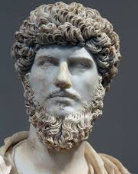 |
Lucio Vero, a strong and famous gladiator. |
Roman gladiators were trained, first and foremost, to kill. Fighting in the Roman coliseum for gladiators was a way of life and the reason they trained their body. They had to be unwavering athletes with great determination. Without enormous courage, you couldn't be a Roman gladiator. You couldn't let your concentration waver. Keep in mind that any mistake, loss of attention or lack of resistance could end your life. For the gladiator, optimal physical condition and mastery of weapons were the most important.
The principles of the training of Roman gladiators
Gladiators had to be highly motivated. They had to not only be the best version of themselves, but always better than their opponents. Not being the best just meant dying in the arena.
Not many fragments have been preserved that describe what the training of a gladiator was like . Therefore, it is difficult to understand exactly his physical preparation. We also know that there was no single way of training for all the gladiators in Rome. The training of the gladiators changed according to the time and geographical situation. The quality of their training and nutrition depended, to a large extent, on the purchasing power of the owners of the gladiator schools.
The more prestigious gladiator schools could provide better gyms and trainers, as well as high-quality doctors and food. For their part, poor schools in peripheral provinces suffered from a lack of resources for their athletes. Here you will discover the ancient training techniques of gladiators according to ancient sources of information. Many of the principles we use in our training today were also used in the ancient world.
Often the story of Milo of Croton is told, who was an ancient Greek athlete from the city-state of Croton in Greece (in what is now southern Italy). Milo lived in the 6th century BC. C. and trained for the Olympic Games. One of his training methods was to take a newborn bull, lift it on his shoulders, and carry it some distance . He did this every day. As time went by, the bull grew larger and Milo gained more and more weight. This culminated in Milo walking into the Olympic stadium with a full grown bull on his shoulders.

Over time, the weight the athlete lifted increased. This is essentially the birth of progressive overload . The ancients knew that if you want your muscles to grow and get stronger, you have to lift heavier and heavier weights.
Another ancient world principle is periodization . Many gladiator gyms probably used sequence training. It consists of dividing the training into blocks of time focused on different skills. The athletes practiced all day and divided their training into blocks of time, during which they focused on a single skill.
The ancient gladiators also knew about the intensity of the training and that you should not go to the maximum at the beginning, but you have to warm up first so as not to get injured. Galen wrote that the intensity must be increased gradually. This must be taken into account, especially to avoid injury to competitors.
The cooling process was also important. Hippocrates (ancient Greek physician) said that "those who walk after exercising find their bodies stronger and more relaxed." This means that after intense exercise, there must be a cool-down period . People should not immediately drop to the ground to lie down, but cool down by walking. Hippocrates also says, that on rest days, an athlete should do nothing at all, but some low intensity exercise. This is now known as active rest .
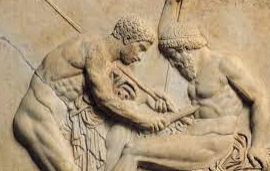
The ancients were well aware of the dangers of excessive exercise, and many physicians preached against it. They knew that the body of muscular gladiators needs rest to recover from intense exercise and that the best results are achieved when rest is part of the routine. We are not surprised to see that these principles are the same that are applied today to sports such as bodybuilding, weightlifting or martial arts .
Diet and the gladiator body
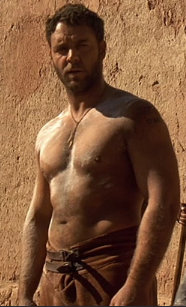
In the Roman coliseum, the gladiators might not have as defined muscles as we have seen in some movies. In fact, what we know about the diet and physique of gladiators suggests something very different from their representation in classical art and contemporary popular culture. Archaeological research suggests that their stomachs and chest were likely covered by a conspicuous layer of subcutaneous fat. Why? Evidence suggests that gladiators ate a lot of carbohydrates . They had a diet high in carbohydrates, such as barley and beans, and low in animal protein. His meals did not resemble the paleo diet or the meat and fish diet now associated with the greatest warriors and athletes.
Interestingly, the researchers found that the gladiators' predominantly vegetarian diet was not the result of their poverty or slave status. Although it is believed that the men and women who fought as gladiators were only slaves, this is only partially true. Although most of the gladiators were prisoners of war and captives, some willingly joined the arena to earn a salary after finishing their initial enlistment. However, it can be assumed that the high carbohydrate diet, mostly without meat, was a cost saving measure. After all, why feed prisoners at exorbitant prices?
The reality is that the carbohydrate improved their performance on the battlefield. A research team from Vienna claims that the wrestlers ate food to gain weight because the extra fat created a protective layer on the body. Thanks to body fat, nerve endings would be less exposed and bleeding wounds would be less dangerous. As a bonus, the extra protective layer of fat would have led to great physical stamina: the gladiators could have been injured and bleed, but because the wounds were superficial thanks to their fat, they could have kept fighting.
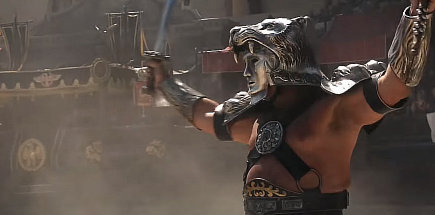 |
| The movie "Gladiator" managed to represent very well what the physique of the Roman gladiators was like. |
The gladiators' extra fat didn't mean they weren't healthy. In fact, both archaeological evidence and contemporary writings suggest otherwise. Gladiators were very important in society. Archaeological evidence shows that the gladiator forts "also had heated houses for winter exercise, baths, infirmaries, a water supply system, and a nearby cemetery." Although they were imprisoned, they probably received excellent medical care. Historical records show, for example, that at least some gladiators were treated by elite doctors., such as Galen of Pergamum, a Greek physician and writer whose theories and research influenced the field of medicine for centuries. The quality of medical care provided to gladiators is also demonstrated by comparing the bone injuries of ordinary citizens with those of gladiators, who show excellent care, as the healing lines of old fractures are clean and smooth.
The good health of the gladiators was not only due to the quality of care. They also regularly drank calcium supplements made from charred plants or bone ashes. Like modern athletes, they took calcium: scientific analyzes describe the calcium levels in gladiators' bones as "excessive" compared to the average citizen. Gladiators sometimes had the chance to indulge in more decadent dishes. At the beginning of the gladiatorial games, the Roman elite organized large banquets to which the combatants could be invited. The historian of the first century B.C. C. Livio described these festivals as shows in which famous animals, athletes and horses were sacrificed.
What was really important in the training of a Roman gladiator?
The main training task for gladiators was to practice with the weapons they would use in the arena. If you wanted to win the battle, you had to be very skilled using your weapon. The main weapons used by gladiators included various types of swords, knives, shields, and special weapons, such as the reticarius trident or the spear. In practice, gladiators used wooden imitations of these weapons. A large part of the training was devoted to practicing with the wooden weaponsagainst other gladiators. In part, heavier wooden weapons were used than those used by gladiators in actual combat. The idea behind training with heavier weapons was that once they were used to fighting with them, it would be much easier to fight with conventional weapons.
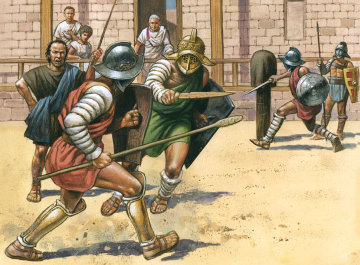
During combat, gladiators were taught how to use the sword correctly. They were instructed to learn not to cut their opponent, but to stab him. This was considered the most effective way to kill or injure an opponent. One of the most important exercises was called the "post" exercise . This was done using ordinary or larger wooden weapons against a large post driven into the ground. The ancient writer Vegetius described the exercise in his book 'De Re Military':
"They gave their young men round bucklers woven from willow, twice as heavy as those used in royal work, and wooden swords twice as heavy as ordinary swords. They practiced both in the morning and in the evening."
Roman gladiators also spent a lot of time practicing unarmed fighting . Things like wrestling were a very important part of a gladiator's training. They not only had to be skilled with a sword, but also capable of fighting with their hands. Few descriptions of the ancient hand-to-hand combat have survived. For example, boxing, wrestling, and the old version of MMA, pankration, were official sports in the ancient Olympic Games.
We do not know how the actual training of unarmed gladiators was carried out, but it likely involved various movements and resembled fighting practices found in second-century AD Greek papyri. C. or even in the wall paintings of ancient Egypt.
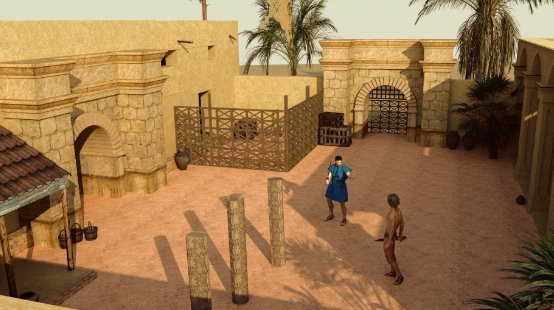
Did gladiators go to the gym?
In terms of discipline, gladiator schools were like prisons. When a gladiator joined a school, he agreed to abide by its strict rules. Even freemen who volunteered to become gladiators were put in chains and had to sleep in cells.
It is said that gladiators only came out of their cells to exercise and eat. They ate three times a day. During meals, they were not allowed to converse. They also had to follow a strict diet and consume plenty of water. The gladiators' health was a particular concern, as they received careful medical attention.
The gladiator training system was strict. The training method varied according to the type of fighter. Gladiators wearing lighter armor had to learn different techniques than those wearing heavier armor. At first, gladiators practiced different fighting styles, but later they used their strength and developed their techniques.
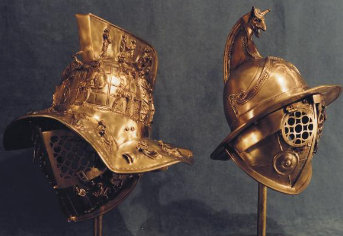 |
| Gladiator helmets. |
Historical data on the physical training of strong gladiators is very imprecise. No doubt many training manuals were produced in Roman times, but very few have survived to the present day. Unfortunately, we cannot deduce a "correct" and complete gladiator training. We can only guess what exercises they did from the few items that have survived.
The trainers of the Roman gladiator gym understood that specific combat exercises were not enough to build the best fighting and killing machine. They knew that to develop strength, speed, and stamina , gladiators had to perform a variety of general exercises. Many of these were based on methods developed by the ancient Greeks .
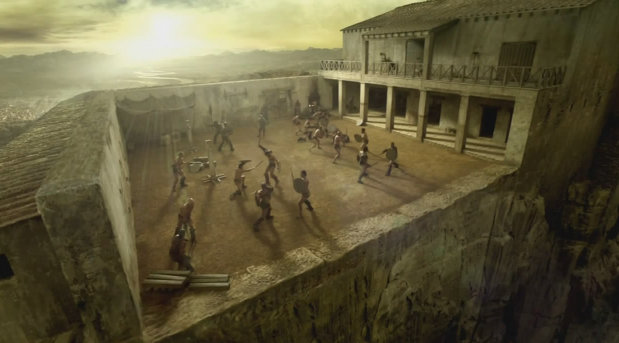 |
| Representation of a school of gladiators in Rome. |
Different gladiator schools and gyms ( "ludi" ) organized their training programs in different ways. During the Roman Empire, the most popular training system was based on the tetrad system developed by the ancient Greeks. The system was divided into four-day periods :
Day 1 : Preparation, which consisted of toning and short, high-intensity exercises.
Day 2 : High intensity, which were long and heavy workouts.
Day 3 : Rest. Short and very light exercises. Above all, he rested.
Day 4 : Medium intensity training.
The Greek philosopher Philostratos, who lived during the time of the Roman Empire, described the tetrad system in his work "Concerning Gymnastics" (one of the first sports science books) as follows: "By the tetrad system, we we refer to a cycle of four days, each dedicated to a different activity.Day one is the preparation of the athlete, day two is a full test, day three is relaxation and day four is moderate training.The first day of training consists of short and intense movements that refresh the athlete and prepare him for the hard training of the next day.This stressful day is the perfect test of his potential.On the third day, the energy is used moderately, while in the middle or last day of training,the athlete practices to break holds and not let his opponent back down."
After day 4, a new tetra cycle began.
What materials did gladiators use in training?
The ancient Greeks and Romans already used a variety of fitness equipment , some of which is very similar to what we use today. They used barbells, an old version of the dumbbell , for training. There were different types of stands, used for different purposes. One of the purposes of the barbell was to help jump farther. For example, Greek long jumpers used to carry these weights in their hands to improve take off. Barbells were also used in various resistance exercises, just as dumbbells are used today. In fact, all of the movements we do with dumbbells today could have been done with barbells in the ancient world.
Other techniques used in ancient times required more natural elements such as large stones, logs, or sandbags . The fighters had different types of stones that they used in gladiator training . These stones could weigh 100 kg or more. Some stones had carved handles, while others were simply round and natural. They could be used for various exercises, such as picking them up off the ground, raising them overhead, throwing them, or, in the case of the heavier ones, simply flipping them over. As you can see, many of these activities are carried out today in bodybuilding, CrossFit or Strongman.
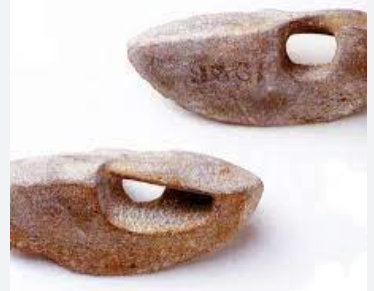 |
| Old halteres. |
The equipment that many ancient physicians recommended as the best for gymnastics were balls . For example, Galen , a Greek physician from the Roman Empire, wrote an entire book on small ball exercises. They were used to play various ball games, but also to perform various exercises. Galen is a very good source of information about gladiators and his training , as he began the practical part of his career as a doctor at the Pergamum gladiator school, where he worked for four years on all types of injuries.
Various punching bags were also used by gladiators to practice their kicks and punches . A very important part of the training day was dedicated to practicing the technique and increasing the power of the blows.
Another team we mentioned was the gymnastics horse . Today, this object is used in gymnastics. There was a version of this artifact in ancient times. Different authors describe it in different ways. The Roman army used it to train its soldiers, so it is possible that gladiators also used it in their training. Other teams we know of from modern gymnastics were also in ancient Greece and Rome. It is also very likely that gladiators used them in their training.
Combat between gladiators
The ultimate goal of the athlete's training was to participate in combat, wrestling, and gladiator fights . They fought in the arena no more than five times a year . Before each fight, the fighters were invited to a banquet and encouraged to enjoy the food as it might be their last fight. However, contrary to popular belief, most gladiators did not die while fighting in the arena .
In the arena, gladiators had to entertain the public and fight well. Otherwise, the audience would get bored and the fight would stop. On the other hand, if the gladiators put on a thrilling performance, both sides of fighters would come out as winners.
Gladiators were undoubtedly very famous figures in ancient Rome. Although they were originally criminals and slaves, punished for fighting and entertaining the masses, their social status later changed. Becoming a gladiator allowed people to gain wealth and fame.
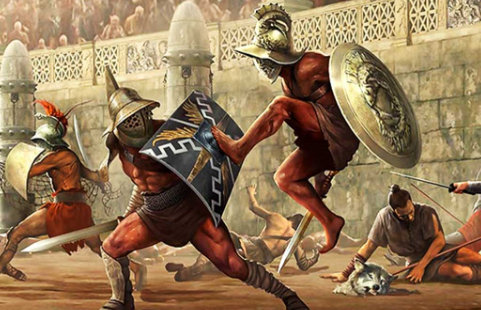
Mimic training to get the physique of gladiators
If you want to achieve the gladiator body, training is essential. It is not known exactly what the routine was like, but we do know something about the exercises they did. Can you do something similar today to get the physique of the muscular gladiators of Rome? Let's look at the three main types of exercises they did.
Vigor or force
These exercises were performed with strength but without speed . Examples include digging, lifting any heavy load and standing (deadlift) or walking (especially uphill), rope climbing, hanging from a rope or beam for as long as possible, holding hands (with or without weights). ) while a partner tries to push them down, etc. These exercises show that the ancient Greeks and Romans understood overload (including progressive overload) and its positive effects on building strength and muscle.
Speed
Here the main goal was speed, in addition to strength and power. Examples are running, shadow boxing, punching with a punching bag, running with balls, arm and leg exercises such as gymnastics, etc. A specific example of this type of exercise was called 'pitylysma' in Greek.
The exercise is as follows: start standing on your toes, raise your arms up, one arm quickly forward and the other back, roll quickly on the ground, quickly get up, stand up straight and begin to jump up and down. down (sometimes kicking back and sometimes alternating both feet forward).
Power
These exercises combine speed and power. They were called "violent" exercises and became power moves if speed was increased. For example, jumping continuously without rest. All speed exercises with weights could be turned into power exercises if the athlete moved quickly in heavy armor.
The word "violent" can be better understood in this context if it is used as a synonym for "power". Galen's recommendation for this type of training was to rest between individual exercises.
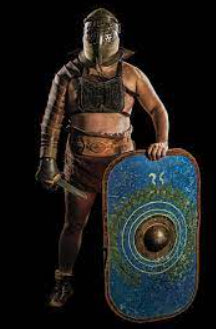 |
| Gladiator armor. |
Example of gym routine for gladiators from Rome
Spiculus was like the Mike Tyson of his time, the best fighter of his generation. Men trained to look and fight like him, and women threw themselves at his feet.
One of Spiculus' training methods was the Tetrad system we mentioned. The training was divided into periods of four days, each of which focused on something different. Would you like to try it?
• Day 1: Preparation . Do short, high-intensity exercises that will prepare you for the next day's training. In actual training, we would include high intensity intervals and sprints.
• Day 2: High intensity . It consisted of long, strenuous workouts and was the perfect test of an athlete's potential. The gladiator was expected to give 110% on this day. In today's workout, you could include the main lifts: squats, push-ups, pull-ups, and the other main exercises we use with barbells and dumbbells.
• Day 3: Rest . The athletes rested or simply did very light exercises. The ancients knew that recovery required rest, and they incorporated this principle into their training systems. Sure, they may not have had massage guns or fancy cryogenic chambers, but they still had plenty of ways to prioritize recovery.
• Day 4: Medium intensity . This day came after a rest day and consisted of moderately intense exercises. Think of it as your "helper day." This day included a lot of skill work for the gladiator, rather than focusing on strength and stamina. After the fourth day, the entire cycle had to be restarted from day one and started all over again.
What other exercises can be applied?
Most gladiator training could be classified as functional training . His program was designed to build functional strength and included various movements, such as jumping and running , in addition to strength exercises . When they performed the exercises at regular intervals, they also increased stamina .
Jumping was a very important part of gladiator training . They would do various plyometric exercises , such as jumping high objects (sometimes, with weights in hand) or jumping obstacles in different ways: from the ground, running, high jump, long jump, etc. An example of an exercise that was popular with trainers was the jumping jack, which is still used today.
Running was also an important part of a Roman gladiator 's activities , whether to gain speed over short distances or stamina over long distances. Lucianus (an Assyrian commentator on Greek writing who lived during the Roman Empire) wrote in "Anarchasis" about the role of running in training routines and recommended running on sand in particular:
"We train youngsters to run by forcing them to endure long distances and also accelerating them at the pace of a sprint. The race is not done on a firm, springy surface, but on deep sand, where it is not easy to force or push the foot as it glides against rough sand. We train them to jump over ditches...or any other obstacle, and we train them to do so even with all the lead weight they can bear."
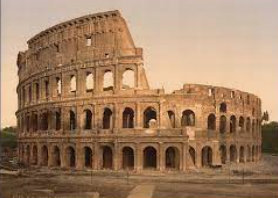
Resistance was practiced throughout the course. Gladiators ran long jogs or practiced various exercises until they got tired. Another very important part of the resistance training was the various ball games .
An example was a game called "harpastum" . No one is quite sure about the rules of this activity, but from the descriptions, it seems to be similar to modern rugby , but it is played with a small ball. This game used to last several hours and was popular with gladiators.
Endurance work was previously mentioned as a very important part of athletic training and was also part of gladiator routines. They used stone or metal gallows or other objects such as stones, wooden blocks or sandbags .
They did things we do today, like lateral raises, bicep curls, or walking lunges . They added a special gladiator touch to their version of the stride. They did them with their arms outstretched in front and holding their shoulders.
In another exercise mentioned by Galen, two dumbbells are placed two meters apart. The person stands between them, reaches for the barbell on one side and lifts it up. Then he walks to the other side and picks up the other dumbbell.
Sandbag training was probably also used . Even the ancient Egyptians practiced this type of exercise. It is a good stabilizer. In addition, with the sandbags you can do many things. An example of a sandbag exercise is the rotation. This is done by placing sandbags over the shoulders and turning the torso from side to side. Another sandbag exercise is to put the bag over your shoulders and do squats . There are many other exercises that can be done with sandbags. They were used in the ancient world to train and strengthen themselves.
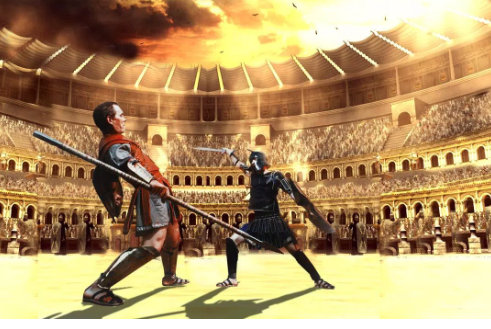
In addition to the above exercises with different equipment, gladiators used bodyweight exercises to build a big, strong body. Calisthenics, or bodyweight exercises, made up a large part of the training for the world's strongest gladiator . Common exercises performed by gladiators were push- ups, sit-ups, lunges, jumping jacks, shrugs, pull-ups, squats, pectoral dips, abdominal planks , etc.
These movements can be performed in different ways to increase resistance. Gladiators performed a variety of push-ups on their knuckles, push-ups, one-armed, one-legged, push-ups, and many others. In the same way, they would also do other types of strength exercises in different ways.
Galen also mentioned the benefits of rope climbing in his writings. Gladiators spent a considerable amount of time climbing ropes. The ropes were suspended from the ceiling , but were often also attached to the ground. Another favorite hobby of the trainers was to have the gladiators hang from ledges or rafters for as long as possible. This type of exercise helped develop a strong grip , as well as other muscles, especially the stabilizer muscles.
Try the following gladiator exercises
If you want to train like a gladiator , how do you do it? Follow the basic principles of progressive overload, periodization, and intensity variation to build strength, speed, and endurance. You can't replicate their entire routine because they trained all day, but you can certainly incorporate elements of their workout into yours. Remember that a large part of gladiator training was with body weight. Try to incorporate this into your routine, and from time to time, make movements more and more difficult.
Also, start training a bit more like a powerlifting competitor. Gladiators always had to move heavy objects to get stronger . You should too. Check out these exercises:
- The farmer's walk.
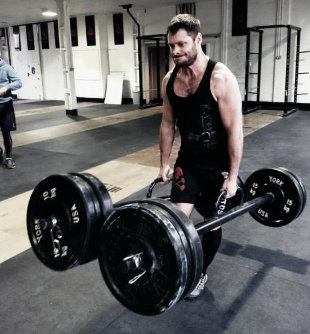
- Lifting heavy objects.
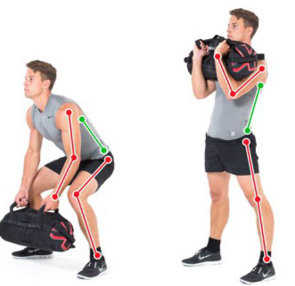
- Some jumping exercises.
- General weight lifting exercises to train like the Greco-Roman warriors.
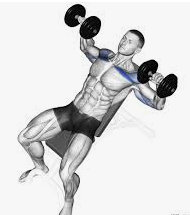
- You can hang suspended from a bar until your grip fails.
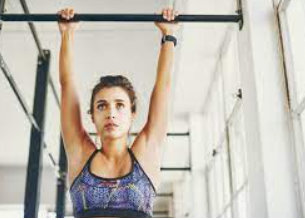
- Gladiators held halteres with their arms outstretched to their sides for as long as they could. You can do it with dumbbells.
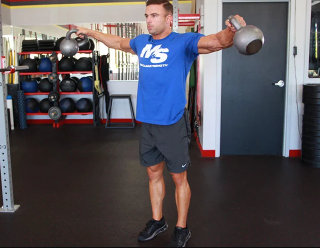
- You can run with a weight vest to increase your stamina. Many gladiators ran long distances in full armor.
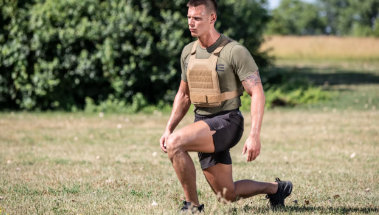
Finally, remember to have fun during your workout. You're lucky you didn't live in a time when going into the arena was life-threatening. You will survive. You just need to focus on getting better without all the nasty stuff. Take the challenge... To become the best, gladiators knew they needed to practice not only speed (and quickness), but also strength and stamina. They also had to practice balance and agility.





![LAS MEJORES MÁQUINAS DE MUSCULACIÓN PARA PRINCIPIANTES [GUÍA 2025]](/modules//smartblog/images/no-home-small.jpg)
![HOW TO BUILD A HOME GYM ON A BUDGET [2024 GUIDE]](/modules//smartblog/images/296-home-small.jpg)


